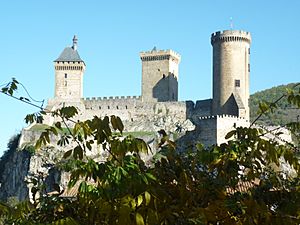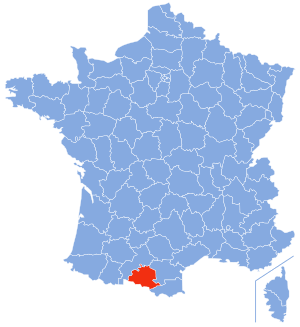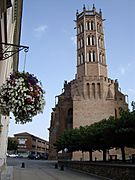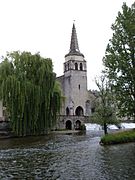Ariège facts for kids
Quick facts for kids
Ariège
|
|||
|---|---|---|---|

The castle of Foix, Ariège.
|
|||
|
|||

Location of Ariège in France
|
|||
| Country | France | ||
| Region | Occitanie | ||
| Prefecture | Foix | ||
| Subprefectures | Pamiers Saint-Girons |
||
| Area | |||
| • Total | 4,889.9 km2 (1,888.0 sq mi) | ||
| Population
(2013)
|
|||
| • Total | 152,684 | ||
| • Rank | 95th | ||
| • Density | 31.2244/km2 (80.8707/sq mi) | ||
| Demonym(s) | Ariègeois, Ariègeoise | ||
| Time zone | UTC+1 (CET) | ||
| • Summer (DST) | UTC+2 (CEST) | ||
| ISO 3166 code | FR-09 | ||
| Arrondissements | 3 | ||
| Cantons | 13 | ||
| Communes | 332 | ||
| Website | www.ariege.fr | ||
Ariège (Catalan: Arieja; Occitan: Arièja) is a department in the region of Occitanie in southern France; it is named after the Ariège river that flows through the department.
The department is surrounded by the French departments of Haute-Garonne to the west and north, Aude to the east, and Pyrénées-Orientales in the south-east, as well as Spain (Lleida) and Andorra in the south.
Contents
History
The department was inhabited in prehistoric times, as evidenced by the presence of caves with cave paintings and dolmens. In historical times it was inhabited by Basque people; they settled on the northern side of the Pyrenees and in the valleys below. In 415 it became part of the kingdom of the Visigoths, until their defeat at the hands of the king of the Franks in 507.
Ariège was created in 1790 during the French Revolution, when the whole of France was divided into departments, replacing the old provinces. Ariège was created combining the counties of Foix (Languedoc) and Couserans (Gascogne).
Geography
Ariège is part of the region Occitanie and has an area of 4,889.9 km2 (1,888 sq mi). Its capital is the city of Foix, with a population of 9,731 inhabitants, but the city with the largest population is Pamiers, with 15,744 inhabitants.
Natural regions
There are three main natural regions in the department:
- The Ariège plain. The north of the department consists of plains, small hills and low valleys where agriculture is an important activity. Two major rivers, the Ariège and the Lèze, flow through the plain from south to north.
- The Pyrenean foothills. This area includes the small mountains and hills below 1,000 m (3,281 ft).
- The Ariége high country. The geography is dominated by the Pyrenees mountains exceeding 1,000 m (3,281 ft) above sea level which form the border between France and Spain.
The highest mountain in the department is the Pica d'Estats (42°40′1″N 01°23′52″E / 42.66694°N 1.39778°E) that is 3,143 m (10,312 ft) high and is on the Spain-France border. Other high mountains are the peak of Montcalm (3,077 m) and the Pic de Sotllo (3,072 m).
The main river is the Ariège river, a tributary of the Garonne river. Another important river is the Lèze, a tributary of the Ariège.
Climate
Two main types of climate are found in Ariège:
- Mediterranean – particularly visible in the vegetation of the foothills and of the valley of the Ariège river towards Tarascon, and in the Sault country
- Continental – in the Pyrenean valleys, with many storms and big differences of temperature between day and night
Temperatures are mild in the foothills, e.g. at the city of Foix (400 metres) the average is 5 °C in January and 19 °C in July. However, they decline rapidly with elevation, e.g. at l'Hospitalet-près-l'Andorre (1,430 m) it is 0 °C in January and 14 °C in July.
| Climate data for Saint-Girons | |||||||||||||
|---|---|---|---|---|---|---|---|---|---|---|---|---|---|
| Month | Jan | Feb | Mar | Apr | May | Jun | Jul | Aug | Sep | Oct | Nov | Dec | Year |
| Average high °C (°F) | 9.9 (49.8) |
11.1 (52.0) |
12.9 (55.2) |
15.0 (59.0) |
18.5 (65.3) |
22.0 (71.6) |
25.0 (77.0) |
24.5 (76.1) |
22.9 (73.2) |
18.8 (65.8) |
13.5 (56.3) |
10.4 (50.7) |
17 (63) |
| Daily mean °C (°F) | 5.1 (41.2) |
6.1 (43.0) |
7.7 (45.9) |
10.1 (50.2) |
13.3 (55.9) |
16.7 (62.1) |
19.4 (66.9) |
19.0 (66.2) |
17.0 (62.6) |
13.1 (55.6) |
8.3 (46.9) |
5.5 (41.9) |
11.8 (53.2) |
| Average low °C (°F) | 0.3 (32.5) |
1.1 (34.0) |
2.6 (36.7) |
5.1 (41.2) |
8.1 (46.6) |
11.5 (52.7) |
13.7 (56.7) |
13.6 (56.5) |
11.1 (52.0) |
7.5 (45.5) |
3.1 (37.6) |
0.7 (33.3) |
6.5 (43.7) |
| Average precipitation mm (inches) | 92.5 (3.64) |
78.3 (3.08) |
92.9 (3.66) |
98.3 (3.87) |
108.8 (4.28) |
90.0 (3.54) |
62.4 (2.46) |
74.0 (2.91) |
73.2 (2.88) |
77.5 (3.05) |
77.2 (3.04) |
88.3 (3.48) |
1,013.4 (39.90) |
| Average precipitation days (≥ 1 mm) | 11.4 | 10.6 | 12.2 | 13.0 | 13.2 | 9.5 | 7.6 | 9.1 | 8.4 | 8.9 | 9.8 | 11.0 | 124.7 |
| Mean monthly sunshine hours | 113.6 | 123.7 | 160.8 | 157 | 180.3 | 195.2 | 227.8 | 205.4 | 199.9 | 173.6 | 127.4 | 107.4 | 1,972 |
| Source: Metereological data for Saint-Girons - Antichan from 1961 to 1990 July 2013 | |||||||||||||
Administration
The department is managed by the General Council of the Ariège in Foix. Argière is part of the region of Occitanie.
Administrative divisions
There are 3 arrondissements (districts), 13 cantons and 332 communes (municipalities) in Argière.
| INSEE code |
Arrondissement | Capital | Population (2013) |
Area (km²) |
Density (Inh./km²) |
Communes |
|---|---|---|---|---|---|---|
| 091 | Foix | Foix | 51,738 | 2,078 | 24.9 | 135 |
| 092 | Pamiers | Pamiers | 73,491 | 1,315 | 55.9 | 115 |
| 093 | Saint-Girons | Saint-Girons | 27,455 | 1,497 | 18.3 | 82 |
-
Cathedral of Saint-Antonin at Pamiers
The following is a list of the 13 cantons of the Ariège department, following the French canton reorganisation which came into effect in March 2015:
- Arize-Lèze
- Couserans Est
- Couserans Ouest
- Foix
- Haute-Ariège
- Mirepoix
- Pamiers-1
- Pamiers-2
- Pays d'Olmes
- Portes d'Ariège
- Portes du Couserans
- Sabarthès
- Val d'Ariège
Demographics
Ariège has a population, in 2013, of 152,684, for a population density of 31.2 inhabitants/km2. The arrondissement of Pamiers, with 73,491 inhabitants, is by far the one with more inhabitants. The other two, Foix and Saint-Girons, have respectively 51,738 and 27,455 inhabitants.
About 25% of the population lives in the four communes with 6,000 or more inhabitants.
The inhabitants of Ariège are known, in French, as ariègeois (women: ariègeoises).
Economy
Agriculture is an important activity in Ariege. Only a small part of its territory is used by farmers; only 132,110 hectares (326,451 acres), 27% of its total area, are used for agriculture in the Ariege.
The Ariège plain is the most fertile area of the department; here farmers grow maize, wheat, sunflower and other crops. The other natural regions are not good for agriculture and are covered with forests or are used for pastures for sheep, cattle and horses.
In the Ax valleys, the mining of talc is the most typical activity. This industry is supplemented by tourism for winter sports.
Hydroelectric production is about one-fifth of the production in the Pyrenees. The hydroelectric plant at Aston has the largest annual production capacity in the Pyrenees.
Related pages
Images for kids













